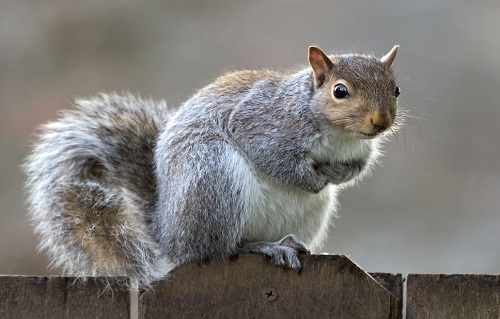Raccoons are a medium sized mammals averaging 14 – 23 lbs. and 24 – 38” long. They are best recognized by their bandit’s mask of black fur that covers their eyes. One theory for their mask feature is that it helps reduce glare and enhance the nocturnal night vision. They have grayish brown fur with dense underfur to help insulate them in the cold. Their tales have five to eight alternating dark and light rings. A raccoons five toes on their front paws are extremely dexterous, functioning as five little fingers which allows them to grasp and manipulate food and other objects, such as doorknobs, garbage can lids, latches and jars. Raccoons typically live in tree cavities, storm drains and burrows but could also find their way into homes mostly in attics and chimneys. They emerge at dusk to search for food. They are omnivorous and opportunistic eaters as their environment dictates their diet. Common foods include garbage, fruits, berries, insects, rodents, plants, nuts, frogs and crayfish. Raccoons are prey of coyotes and foxes. Raccoon mating season falls generally anytime between January and June. Most females begin reproducing around the age of one and give birth to litters of 2 – 5 kits, typically in the spring. The mother will separate from other raccoons to raise her young alone as the males do not partake in the raising of the kits. The kits stay in the den with their mother until they are about 8 – 10 weeks old and will continue to stay with her until they reach 13 -14 months of age. Raccoons are known to be highly susceptible to carrying and transmitting rabies, but rabies is not the only health risk raccoons pose to humans. Raccoons are also the primary host of a roundworm that can be harmful to humans. Roundworm eggs are passed in the feces of infected raccoons and people can become infected by ingesting the eggs. Young children are especially at risk as they are more likely to put contaminated fingers, soil or other objects into their mouths. Eggs in newly deposited feces are not infectious and take at least 2 – 4 weeks to become infective.
black fur that covers their eyes. One theory for their mask feature is that it helps reduce glare and enhance the nocturnal night vision. They have grayish brown fur with dense underfur to help insulate them in the cold. Their tales have five to eight alternating dark and light rings. A raccoons five toes on their front paws are extremely dexterous, functioning as five little fingers which allows them to grasp and manipulate food and other objects, such as doorknobs, garbage can lids, latches and jars. Raccoons typically live in tree cavities, storm drains and burrows but could also find their way into homes mostly in attics and chimneys. They emerge at dusk to search for food. They are omnivorous and opportunistic eaters as their environment dictates their diet. Common foods include garbage, fruits, berries, insects, rodents, plants, nuts, frogs and crayfish. Raccoons are prey of coyotes and foxes. Raccoon mating season falls generally anytime between January and June. Most females begin reproducing around the age of one and give birth to litters of 2 – 5 kits, typically in the spring. The mother will separate from other raccoons to raise her young alone as the males do not partake in the raising of the kits. The kits stay in the den with their mother until they are about 8 – 10 weeks old and will continue to stay with her until they reach 13 -14 months of age. Raccoons are known to be highly susceptible to carrying and transmitting rabies, but rabies is not the only health risk raccoons pose to humans. Raccoons are also the primary host of a roundworm that can be harmful to humans. Roundworm eggs are passed in the feces of infected raccoons and people can become infected by ingesting the eggs. Young children are especially at risk as they are more likely to put contaminated fingers, soil or other objects into their mouths. Eggs in newly deposited feces are not infectious and take at least 2 – 4 weeks to become infective.
 black fur that covers their eyes. One theory for their mask feature is that it helps reduce glare and enhance the nocturnal night vision. They have grayish brown fur with dense underfur to help insulate them in the cold. Their tales have five to eight alternating dark and light rings. A raccoons five toes on their front paws are extremely dexterous, functioning as five little fingers which allows them to grasp and manipulate food and other objects, such as doorknobs, garbage can lids, latches and jars. Raccoons typically live in tree cavities, storm drains and burrows but could also find their way into homes mostly in attics and chimneys. They emerge at dusk to search for food. They are omnivorous and opportunistic eaters as their environment dictates their diet. Common foods include garbage, fruits, berries, insects, rodents, plants, nuts, frogs and crayfish. Raccoons are prey of coyotes and foxes. Raccoon mating season falls generally anytime between January and June. Most females begin reproducing around the age of one and give birth to litters of 2 – 5 kits, typically in the spring. The mother will separate from other raccoons to raise her young alone as the males do not partake in the raising of the kits. The kits stay in the den with their mother until they are about 8 – 10 weeks old and will continue to stay with her until they reach 13 -14 months of age. Raccoons are known to be highly susceptible to carrying and transmitting rabies, but rabies is not the only health risk raccoons pose to humans. Raccoons are also the primary host of a roundworm that can be harmful to humans. Roundworm eggs are passed in the feces of infected raccoons and people can become infected by ingesting the eggs. Young children are especially at risk as they are more likely to put contaminated fingers, soil or other objects into their mouths. Eggs in newly deposited feces are not infectious and take at least 2 – 4 weeks to become infective.
black fur that covers their eyes. One theory for their mask feature is that it helps reduce glare and enhance the nocturnal night vision. They have grayish brown fur with dense underfur to help insulate them in the cold. Their tales have five to eight alternating dark and light rings. A raccoons five toes on their front paws are extremely dexterous, functioning as five little fingers which allows them to grasp and manipulate food and other objects, such as doorknobs, garbage can lids, latches and jars. Raccoons typically live in tree cavities, storm drains and burrows but could also find their way into homes mostly in attics and chimneys. They emerge at dusk to search for food. They are omnivorous and opportunistic eaters as their environment dictates their diet. Common foods include garbage, fruits, berries, insects, rodents, plants, nuts, frogs and crayfish. Raccoons are prey of coyotes and foxes. Raccoon mating season falls generally anytime between January and June. Most females begin reproducing around the age of one and give birth to litters of 2 – 5 kits, typically in the spring. The mother will separate from other raccoons to raise her young alone as the males do not partake in the raising of the kits. The kits stay in the den with their mother until they are about 8 – 10 weeks old and will continue to stay with her until they reach 13 -14 months of age. Raccoons are known to be highly susceptible to carrying and transmitting rabies, but rabies is not the only health risk raccoons pose to humans. Raccoons are also the primary host of a roundworm that can be harmful to humans. Roundworm eggs are passed in the feces of infected raccoons and people can become infected by ingesting the eggs. Young children are especially at risk as they are more likely to put contaminated fingers, soil or other objects into their mouths. Eggs in newly deposited feces are not infectious and take at least 2 – 4 weeks to become infective.
